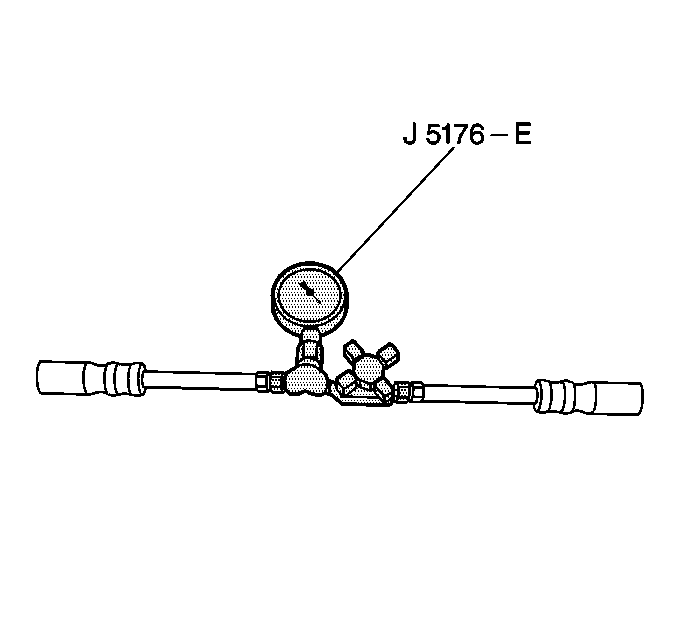Tools Required
| • | J 5176-E Power Steering Pressure Tester |
| • | J 5421-02 Thermometer |
Use the power steering system test in order to identify and isolate hydraulic circuit difficulties. Prior to performing this test, inspect the following components and repair as necessary:
| • | The fluid level in the pump reservoir |
| • | The pump belt tension |
| • | The pump drive pulley condition |
Important: Perform all of the tests with the engine idling at normal operating temperature.
- Turn OFF the engine.
- Place a container under the steering gear or the pump in order to catch the fluid when you disconnect the hoses.
- Disconnect the pressure hose at the steering gear or the power steering pump.
- Install J 5176-E to both of the hoses.
- Open the shutoff valve.
- Remove the filler cap from the pump reservoir.
- Inspect the fluid level.
- Start the engine.
- While momentarily holding the steering wheel against the stop, inspect the connections at J 5176-E for leaks.
- Bleed the system.
- Insert the thermometer J 5421-02 in the reservoir filler opening.
- Move the steering wheel from stop to stop several times until the thermometer indicates that the hydraulic fluid in the reservoir has reached 65° to 77°C (150° to 170°F).
- Inspect the fluid level in the reservoir.
- Read the initial pressure reading on J 5176-E with the valve open and the pressure should be between 550-860 kPa (80-125 psi).
- Fully close the shutoff valve three times.
- If the pump is within specifications, leave the valve open.
- Record the highest pressures.
- Compare the pressures with the maximum pump pressure recorded.
- Turn OFF the engine.
- Remove the testing gauge.
- Reconnect the pressure hose.
- Inspect the fluid levels.
- Thoroughly examine the steering and the front suspension if the problem still exists.

Ensure that the gauge is between the shutoff valve and the pump.
Fill the pump reservoir with power steering fluid to the full mark on the dipstick.
Refer to Power Steering System Bleeding .
Important: In order to prevent scrubbing flat spots on the tires, do not turn the steering wheel more than five times without rolling the vehicle in order to change the tire-to-floor contact area.
Add power steering fluid if required. Refer to Checking and Adding Power Steering Fluid .
If the pressure exceeds 1380 kPa (200 psi), inspect the hoses for restrictions and inspect the steering gear check valve for proper assembly.
Notice: Do not leave the valve fully closed for more than 5 seconds, or the pump could be damaged internally.
Record the highest pressures that are attained each time.
| • | The pump is functioning with specifications if the recorded pressures are between 7585-8264 kPa (1100-1200 psi) and the range of readings is within the 345 kPa (50 psi) range. |
| • | The control valve is sticking if the recorded pressures are high but do not repeat within 345 kPa (50 psi). |
| 1. | Remove the valve. |
| 2. | Clean the valve. |
Use a crocus cloth or a fine hone in order to remove any burrs.
| 3. | Flush the system if the system contains dirt. Refer to Power Steering System Flushing . |
| 4. | If the system is exceptionally dirty, disassemble the pump and the gear. |
Clean and flush the components before reassembly and further use.
| • | Replace the flow control valve if the recorded pressures are constant but more than 690 kPa (100 psi) and below 7585 kPa (1100 psi). |
| • | If the pressures remain low, replace the rotating group in the pump. |
Turn the steering wheel to both stops.
If the pressure can not be reached in either or one side of the gear, then the gear is leaking internally. Disassemble and repair the gear.
Make any necessary repairs.
Refer to the appropriate diagnostic table.
